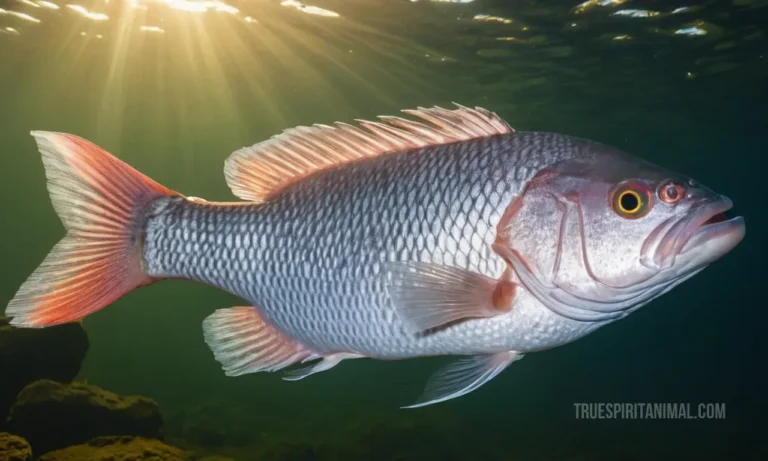White Bass Symbolism and Meaning

The white bass is a freshwater fish found in lakes and rivers across much of North America. With its distinctive silver body and dark horizontal stripes, the white bass has come to hold symbolic meaning for many cultures.
In this blog post, we’ll explore some of the key symbolic interpretations of the white bass and what they can teach us. Whether you’re curious about animal symbolism or simply want to learn more about this popular game fish, read on for an informative guide.
White Bass as a Symbol of Abundance
One of the most common symbolic meanings associated with the white bass is that of abundance and prosperity.
The white bass tends to school in very large numbers, with some spawning runs consisting of hundreds of thousands of fish. This impressive massing behavior has led many to see the humble white bass as a sign of bounty.
In the belief system of some Native American tribes, catching a white bass represents the promise of a fruitful harvest. More broadly, the white bass can be a reminder to appreciate the abundance already present in your life.
Adaptability and Resilience
Another key aspect of white bass symbolism is adaptability and resilience.
White bass are able to thrive in a wide range of habitats. They can be found everywhere from fast-moving streams to sluggish marshes and reservoirs. And they are well equipped to handle fluctuations in water flow, temperature, and other environmental factors.
When the white bass appears symbolically, it may be a prompt to assess your own flexibility. Are you willing to adjust to new circumstances? Or has your thinking become rigid and limited? The white bass encourages us to be more open and adaptable.

Leadership and Community
As schooling fish, white bass also exemplify the symbolic values of leadership and community.
White bass tend to coordinate their behaviors as a group, allowing the school to move as one. This requires leadership fish that can guide the school’s direction. It also relies on each member fulfilling its role.
In this way, the white bass reminds us of the importance of cooperation, coordination, and leadership. It takes the group working together harmoniously to thrive.
When we see the white bass, it’s a great time to consider our own communities. Are we participating actively while also supporting effective leaders? If so, our “schools” can achieve great things.
Key Takeaways
- The white bass symbolizes abundance and prosperity, given its tendency to school in huge numbers during spawning runs.
- As an adaptable fish able to thrive in many habitats, the white bass represents resilience and flexibility.
- White bass schools demonstrate leadership and community values like cooperation and coordination.
Incorporating White Bass Symbolism
If you find white bass symbolism meaningful, there are a few ways you can incorporate it into your life:
- Learn more about real white bass behavior and biology by reading about this fish species or even fishing for them yourself. Seeing the symbolic meanings come to life can deepen your appreciation.
- Use white bass imagery like photos or artwork as a symbolic reminder. You might even get a white bass tattoo to keep the symbolic wisdom close.
- Share white bass symbolism by teaching others or using this fish in stories, poems, or other creative works. Spreading awareness can affirm the meaning.
- When facing challenges in your own life, recall white bass resilience and flexibility. Or when working in a team, think of the coordination within a white bass school.
No matter how you choose to engage with it, white bass symbolism has much to teach us. This freshwater fish’s ability to prosper, adapt, and school in harmony makes it an emblem of abundance, resilience, leadership, and community. By taking inspiration from the white bass, we can lead more fruitful and cooperative lives ourselves.
FAQs about White Bass
1. What is the scientific name of white bass?
The scientific name of white bass is Morone chrysops.
2. Where are white bass commonly found?
White bass are widely distributed across North America, inhabiting large reservoirs and rivers. They are especially abundant in the Midwest, including areas around Lake Erie, Pennsylvania, and Oklahoma.
3. What is the average size of white bass?
White bass commonly grow to be around 12-15 inches long, but they can reach lengths of up to 17 inches or more.
4. What do white bass eat?
White bass are carnivores and have a diverse diet. They primarily feed on calanoid copepods, cyclopoid copepods, daphnia, and leptodora. They are visual feeders and readily bite live bait such as worms and minnows.
5. When does white bass spawn?
The spawning season for white bass is typically from mid-March to late May. They prefer water temperatures between 12 and 20 °C (54 to 68 °F). Females release a large number of eggs, which stick to the surface of objects in clear, relatively shallow water.





